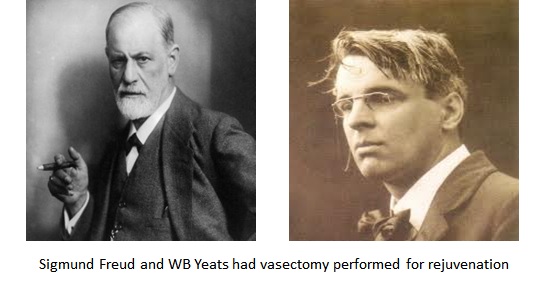In 1902, Bilateral Vasectomy was first established to be effective in reducing the incidence of epididymitis after prostatectomy. The medical profession had sought hard to find an alternative to the existing practice of castration for enlarged prostate, and it was established by White that vasectomy was an effective treatment. One of the reasons an alternative was sought is because of the reputed case whereby a disgruntled patient murdered a surgeon! Vasectomy remained in common use as a cure for post-prostate surgery until antibiotics were common place.
In 1907, Parlovechoi first attempted to reverse an accidental vasectomy that occurred in a hernia operation. Later authors describe the technique under the names of Vasorraphy or vasovasal anastomis.
During 1907-1910 Vasectomy is recommended to be used to sterilize “the undesirables” of the world. Belfield publishes his paper “Race suicide for social parasites”. He was one of the proponents of enforced vasectomy for criminals. This is where the Eugenics movement comes into play. In 1910 Russia sent a delegate to the United States to observe a male prisoner being sterilized.

In 1918 the first vasectomy on humans is performed for rejuvenation. This was done based on experiments of old senile rats that were transformed after obstructing the outflow from the testes. Two notable people, Sigmund Freud and WB Yeats had vasectomy performed for rejuvenation.
Twyman and Nelson reported a successful case of a vasectomy anastomosis known as a reversal in1938. The patient had a reversal 4 years after having an elective vasectomy. The procedure was recommended due to depression caused by the desire to father children. After the procedure the patient’s emotional condition improved and he was able to father children.
By 1948 the list of indications for vasectomy were: prevention of the insane, criminal or perverse producing offspring, the wife having precarious health and is unable or refuses to undergo tubal ligation, an agreement between the husband and wife to prevent pregnancy, to prevent epididymitis following prostrate surgery, male rejuvenation, and mass sterilization for the purpose of racial limitation/extermination.
In the 1950’s a case is reported of a vassoraphy or repair performed 10 years after the original vasectomy with complete function. The patient’s wife was able to become pregnant 6 months after the procedure. Vasectomy is becoming favorable for use for sterilization. By 1953, vasectomy procedures had been watched for a period of 30 years and were found to have no adverse side effects. Any complications were reported were a result of technical surgical errors. In 1955 Jhaver introduces the single incision, single stitch approach. The advantage being that a bilateral vasectomy was possible using one incision with less surgical trauma and post-operative care. He publishes his technique in 1958.
New techniques continue to appear for vasectomies. In 1967 a new technique is introduced in India by Kothari and Pardanani. They demonstrated that it’s possible to produce a sub fertile sperm count by using a synthetic thread to temporarily obstruct the vas deferens. Removing it would restore fertility. Based on two cases the thread was left in for 20 weeks and 6 weeks later fertility had returned to previous levels. No-scalpel vasectomy was developed in China in 1974 by Dr. Li Shungiang of Chongqing Family Planning Research Institute, Sichuan province. Tubal ligation was the most commonly used method of voluntary sterilization. Vasectomy was not popular with Chinese men. The new technique was minimally invasive with a much lower complication than the conventional method.
This is the final part of the long and interesting history of the Vasectomy. The first non-scalpel vasectomy was not performed until 1985 in the United States by Dr. Mark Goldstein at the New York Presbyterian Hospital Cornell Medical Center. He was a member of the international team, sponsored by the Association of Voluntary Surgical Contraception that went to China to learn the procedure. The procedure was then introduced to other countries by the other team members.
In 1999 the no-needle vasectomy is introduced after 6 years of preparation. A spray jet injector was used for the local anesthesia. This technique was developed by Dr. Charles L. Wilson of Seattle, WA in consultation with the late Dr. Ralph Adam who was the inventor of the MadaJet device used in this technique. The local anesthesia given with 30 gauge needle is almost painless in the good hands, mild pain while given anesthesia is actually caused by the acidic lidocaine, but the application of Madajet does reduce the anxiety in the needle phobia patients.



